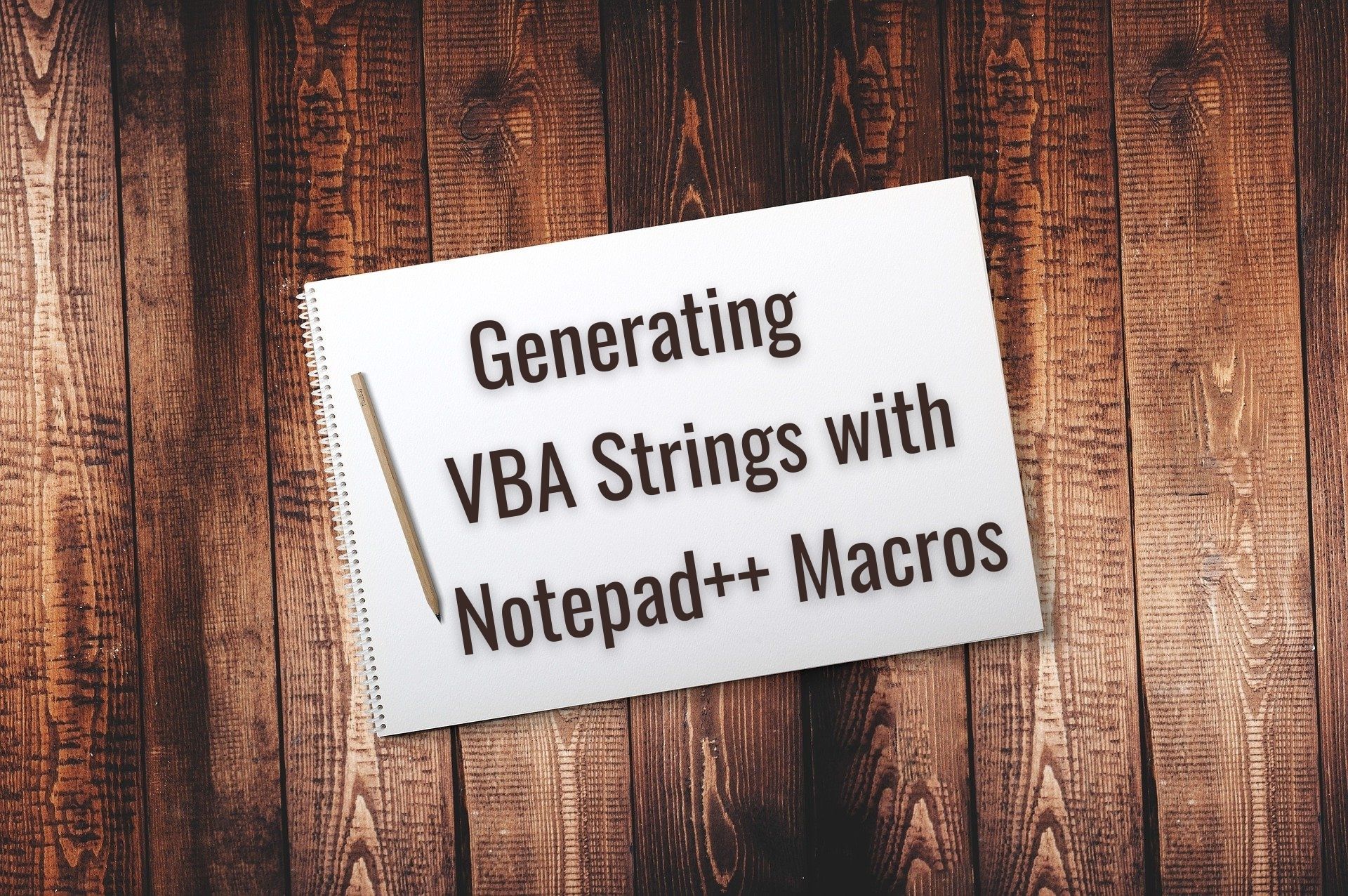Create a Class Module from a String in Microsoft Access
Generate VBA class modules from strings during design time using this simple function in Microsoft Access.

NOTE: This article is about how to create class modules from strings in Microsoft Access. I wrote a different article with a function to create standard modules.
Writing boilerplate code is a necessary evil in VBA. And writing it by hand has some real drawbacks:
- It is tedious
- It creates more opportunities for bugs
- It is prone to silly mistakes
- Refactoring the underlying logic must be done in multiple places
One way to avoid these downsides–especially the last one–is to automate the generation of the boilerplate code.
Starting Point
For the purposes of this article, we will assume that you already have a string with the contents of a VBA class module.
How you build that string will vary widely from situation to situation. One technique that may help with the string-building portion is my Notepad++ VBA code generation trick.

Once you have your string, the UpsertClassModule procedure below will create or overwrite a standard code module with its contents.
The Approach
The function is quite simple:
- Prefix the class module contents with the hidden attributes of a class module
- Write the contents of the combined string to a temp file
- Load the text file as a class module
- Delete the temp file
For simplicity, we take advantage of the Access Application object's undocumented LoadFromText function. This lets us avoid having to write code against the VBA Extensibility library. The downside is that it only runs in Microsoft Access. One could write a more general VBA function relatively easily, but it would be (much) more verbose.
Hidden Class Module Attributes
Unlike standard modules, VBA class modules contain four hidden attributes that are not visible in the VBA IDE:
VB_GlobalNamespaceVB_CreatableVB_PredeclaredIdVB_Exposed
You can read about these attributes here and here.
If you create a new class module in an Access application, save it with a default name of Class1.txt, and then use the SaveAsText method to export it to a text file, you can see these attributes (all set to their default values of False):

The UpsertClassModule Subroutine
Here is the subroutine on its own without its required dependencies:
Public Sub UpsertClassModule(ClassName As String, Contents As String, _
Optional PredeclaredId As Boolean = False, _
Optional Creatable As Boolean = False, _
Optional Exposed As Boolean = False, _
Optional GlobalNameSpace As Boolean = False)
'Build hidden attribute string to prepend to the class module's contents;
' we use IIf() to return a literal "True" or "False" value so that
' the code works properly when the system language is not set to English
Dim HiddenAttributes As String
HiddenAttributes = _
"Attribute VB_GlobalNameSpace = " & IIf(GlobalNameSpace, "True", "False") & vbNewLine & _
"Attribute VB_Creatable = " & IIf(Creatable, "True", "False") & vbNewLine & _
"Attribute VB_PredeclaredId = " & IIf(PredeclaredId, "True", "False") & vbNewLine & _
"Attribute VB_Exposed = " & IIf(Exposed, "True", "False") & vbNewLine
'Write the future class module's contents to a temporary file
Dim fpTemp As String
fpTemp = WriteTempFile(HiddenAttributes & Contents)
'LoadFromText the contents of the temp file
LoadFromText acModule, ClassName, fpTemp
'Delete the temp file
Kill fpTemp
End SubThe Full Code
The code below includes required helper functions that I've written about in the past:
- WriteTempFile(): A Simple VBA Function to Save Text to a New Temporary File
- CreateGuid: A Reliable Way to Generate GUIDs in VBA
- A GUID-Based Temporary File Name Generator
The code can be copied and pasted into a blank standard module to get a fully-working solution that you can easily integrate into your projects:
Option Compare Database
Option Explicit
'--== Declare lines for CreateGUID() ==--
#If VBA7 Then
Private Declare PtrSafe Function CoCreateGuid Lib "ole32" (id As Any) As Long
#Else
Private Declare Function CoCreateGuid Lib "ole32" (id As Any) As Long
#End If
'--== Declare lines for DeleteFile() ==--
#If VBA7 Then
Private Declare PtrSafe Sub Sleep Lib "kernel32" (ByVal dwMilliseconds As Long)
#Else
Private Declare Sub Sleep Lib "kernel32" (ByVal dwMilliseconds As Long)
#End If
' ----------------------------------------------------------------
' Procedure : UpsertClassModule
' Date : 10/18/2022
' Author : Mike Wolfe
' Source : https://nolongerset.com/upsertclassmodule/
' Purpose : Creates or updates a class module.
' Notes - This routine only runs in Microsoft Access, as it
' takes advantage of the undocumented Access
' Application method, LoadFromText.
' ----------------------------------------------------------------
Public Sub UpsertClassModule(ClassName As String, Contents As String, _
Optional PredeclaredId As Boolean = False, _
Optional Creatable As Boolean = False, _
Optional Exposed As Boolean = False, _
Optional GlobalNameSpace As Boolean = False)
'Build hidden attribute string to prepend to the class module's contents;
' we use IIf() to return a literal "True" or "False" value so that
' the code works properly when the system language is not set to English
Dim HiddenAttributes As String
HiddenAttributes = _
"Attribute VB_GlobalNameSpace = " & IIf(GlobalNameSpace, "True", "False") & vbNewLine & _
"Attribute VB_Creatable = " & IIf(Creatable, "True", "False") & vbNewLine & _
"Attribute VB_PredeclaredId = " & IIf(PredeclaredId, "True", "False") & vbNewLine & _
"Attribute VB_Exposed = " & IIf(Exposed, "True", "False") & vbNewLine
'Write the future class module's contents to a temporary file
Dim fpTemp As String
fpTemp = WriteTempFile(HiddenAttributes & Contents)
'LoadFromText the contents of the temp file
LoadFromText acModule, ClassName, fpTemp
'Delete the temp file
Kill fpTemp
End Sub
' ----------------------------------------------------------------
' Procedure : WriteTempFile
' Date : 10/11/2022
' Author : Mike Wolfe
' Source : https://nolongerset.com/writetempfile/
' Purpose : Save the passed Contents to a GUID-based temporary file.
' Returns : The full path to the temporary file.
' Notes - Since the file name is based on a GUID, we don't
' need to check if the file already exists.
' ----------------------------------------------------------------
Private Function WriteTempFile(Contents As String, Optional FileExt As String = "txt") As String
Dim fpTemp As String: fpTemp = GetGuidBasedTempPath(FileExt)
Dim FNum As Integer
FNum = FreeFile()
Open fpTemp For Output As FNum
'trailing semi-colon needed to prevent adding blank line at end of file
' see: http://stackoverflow.com/a/9445141/154439
Print #FNum, Contents;
Close #FNum
WriteTempFile = fpTemp
End Function
' ----------------------------------------------------------------
' Procedure : GetGuidBasedTempPath
' Date : 9/30/2022
' Author : Mike Wolfe
' Source : https://nolongerset.com/getguidbasedtemppath/
' Purpose : Returns an unused full path in the user's temp folder.
' Requires : CreateGUID() from https://nolongerset.com/createguid/
' Notes - For efficiency, the file name is based on a GUID which
' obviates the need to check for an existing file.
' Usage : ?GetGuidBasedTempPath() 'produces something like:
' C:\Users\Mike\AppData\Local\Temp\11132708-F988-E84A-ADB0-F27F133B2116.tmp
' ----------------------------------------------------------------
Private Function GetGuidBasedTempPath(Optional FileExt As String = "tmp")
'Build the destination folder with trailing slash
Dim foDest As String
foDest = Environ("TMP")
If Right(foDest, 1) <> "\" Then foDest = foDest & "\"
'Build the destination filename with extension
Dim fnDest As String
fnDest = CreateGUID() & "." & FileExt
'Combine the folder and filename to create the full path
GetGuidBasedTempPath = foDest & fnDest
End Function
' ----------------------------------------------------------------
' Procedure : CreateGUID
' Author : Dan (webmaster@1stchoiceav.com)
' Source : http://allapi.mentalis.org/apilist/CDB74B0DFA5C75B7C6AFE60D3295A96F.html
' Adapted by : Mike Wolfe
' Republished: https://nolongerset.com/createguid/
' Date : 8/5/2022
' ----------------------------------------------------------------
Private Function CreateGUID() As String
Const S_OK As Long = 0
Dim id(0 To 15) As Byte
Dim Cnt As Long, GUID As String
If CoCreateGuid(id(0)) = S_OK Then
For Cnt = 0 To 15
CreateGUID = CreateGUID & IIf(id(Cnt) < 16, "0", "") + Hex$(id(Cnt))
Next Cnt
CreateGUID = Left$(CreateGUID, 8) & "-" & _
Mid$(CreateGUID, 9, 4) & "-" & _
Mid$(CreateGUID, 13, 4) & "-" & _
Mid$(CreateGUID, 17, 4) & "-" & _
Right$(CreateGUID, 12)
Else
MsgBox "Error while creating GUID!"
End If
End FunctionSample Usage
Sub SampleUsage()
Dim s As String
s = s & "Option Explicit" & vbNewLine
s = s & "Option Compare Database" & vbNewLine
s = s & vbNewLine
s = s & "Property Get TheAnswer() As Integer" & vbNewLine
s = s & " TheAnswer = 42" & vbNewLine
s = s & "End Property" & vbNewLine
UpsertClassModule "Guide", s, True
End Sub
Caveat Emptor
I should point out here that the UpsertClassModule code is intended to be used at DESIGN TIME by you, the developer. It is not intended to generate code on the fly at run time. It might work. In fact, it probably will work–especially on your development machine. But it might also trigger the heuristic analysis scanners for some of your users with modern anti-virus software, thus blocking your application from running at all.
Referenced Articles

External References


Image by Mac Garrison from Pixabay
UPDATE [2024-01-02]: Bug fix: used IIf(Condition, "True", "False") when populating the Hidden Attributes so that the code works when English is not the system language. For example, when the system language is Italian, True gets translated to "Vero" and False gets translated to "Falso" (h/t Lorenzo in the comments below).

